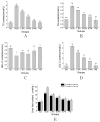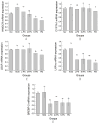Nano-Encapsulated Phytosterols Ameliorate Hypercholesterolemia in Mice via Dual Modulation of Cholesterol Metabolism Pathways
- PMID: 40647191
- PMCID: PMC12252197
- DOI: 10.3390/nu17132086
Nano-Encapsulated Phytosterols Ameliorate Hypercholesterolemia in Mice via Dual Modulation of Cholesterol Metabolism Pathways
Abstract
Background: The limited bioavailability of free phytosterols restricts their clinical application in managing hypercholesterolemia. This study aimed to develop phytosterol nanoparticles (PNs) to enhance bioactivity and investigate their cholesterol-lowering efficacy and underlying mechanisms in vivo. Methods: Phytosterol nanoparticles (PNs) (93.35 nm) were engineered using soy protein isolate and administered orally at concentrations of 4.00-12.50 mg/mL to high-fat-diet-induced hypercholesterolemic mice (n = 60) over a 4-week period. Serum and hepatic lipid profiles, histopathology, gene/protein expression related to cholesterol metabolism, and fecal sterol content were evaluated. Results: PNs dose-dependently reduced serum total cholesterol (TC: 28.6-36.8%), triglycerides (TG: 22.4-30.1%), and LDL-C (31.2-39.5%), while increasing HDL-C by 18.7-23.4% compared to hyperlipidemic controls (p < 0.01). Hepatic TC and TG accumulation decreased by 34.2% and 41.7%, respectively, at the highest dose, with histopathology confirming attenuated fatty degeneration. Mechanistically, PNs simultaneously suppressed cholesterol synthesis through downregulating HMGCR (3.2-fold) and SREBP2 (2.8-fold), while enhancing cholesterol catabolism via CYP7A1 upregulation (2.1-fold) at protein level. Although less potent than simvastatin (p < 0.05), the nanoparticles exhibited unique dual-pathway modulation absent in conventional phytosterol formulations. Fecal analysis revealed dose-responsive cholesterol excretion (36.01 vs. 11.79 mg/g in controls), indicating enhanced enteric elimination. While slightly less potent than simvastatin (p < 0.05), PNs offered unique dual-pathway modulation absent in conventional phytosterol formulations. Conclusions: Nano-encapsulation significantly improves the bioavailability and hypocholesterolemic efficacy of phytosterols. PNs represent a promising nutraceutical strategy for cholesterol management by concurrently regulating cholesterol synthesis and catabolism, with potential application in both preventive and therapeutic contexts.
Keywords: CYP7A1; cholesterol regulation; high-fat diet; mouse; phytosterol nanoparticles.
Conflict of interest statement
The authors declare no conflicts of interest.
Figures





Similar articles
-
Submicron Dispersions of Phytosterols Reverse Liver Steatosis with Higher Efficacy than Phytosterol Esters in a Diet Induced-Fatty Liver Murine Model.Int J Mol Sci. 2025 Jan 10;26(2):564. doi: 10.3390/ijms26020564. Int J Mol Sci. 2025. PMID: 39859279 Free PMC article.
-
Study on the modulation of kidney and liver function of rats with diabetic nephropathy by Huidouba through metabolomics.J Ethnopharmacol. 2025 Jul 24;351:120136. doi: 10.1016/j.jep.2025.120136. Epub 2025 Jun 11. J Ethnopharmacol. 2025. PMID: 40513925
-
Effects of phytosterol supplementation on lipid profiles in patients with hypercholesterolemia: a systematic review and meta-analysis of randomized controlled trials.Food Funct. 2023 Apr 3;14(7):2969-2997. doi: 10.1039/d2fo03663k. Food Funct. 2023. PMID: 36891733
-
Phytosterols/stanols lower cholesterol concentrations in familial hypercholesterolemic subjects: a systematic review with meta-analysis.J Am Coll Nutr. 2006 Feb;25(1):41-8. doi: 10.1080/07315724.2006.10719513. J Am Coll Nutr. 2006. PMID: 16522931
-
Rhein alleviates hepatic steatosis in NAFLD mice by activating the AMPK/ACC/SREBP1 pathway to enhance lipid metabolism.Mol Med. 2025 Jul 10;31(1):255. doi: 10.1186/s10020-025-01304-4. Mol Med. 2025. PMID: 40640749 Free PMC article.
References
-
- Mormone A., Tortorella G., Esposito F., Caturano A., Marrone A., Cozzolino D., Galiero R., Marfella R., Sasso F.C., Rinaldi L. Advances in Pharmacological Approaches for Managing Hypercholesterolemia: A Comprehensive Overview of Novel Treatments. Biomedicines. 2024;12:432. doi: 10.3390/biomedicines12020432. - DOI - PMC - PubMed
MeSH terms
Substances
Grants and funding
LinkOut - more resources
Full Text Sources
Medical
Miscellaneous

